
Stop overpaying - start transferring money with Ogvio. Sign up, invite friends & grab Rewards now! 🎁
If you’ve been exploring secure options to safeguard your cryptocurrency, you’ve likely come across hardware wallets. Among the many choices, Keevo Wallet stands out with its advanced features like biometric security and a sleek touchscreen interface. To help you understand more, this Keevo Wallet review will delve into what makes this wallet a popular choice among crypto enthusiasts.
As we unpack its functionalities, you may wonder: Is it any good and reliable? How does it compare with popular wallets like Ledger Nano X and Trezor Safe 5?
Don't worry. From its setup process to its usability, I’ll guide you through all aspects of the Keevo Wallet. Therefore, you'll have the information needed to decide if this is the right solution for your digital asset storage.
Verdict at a Glance: Keevo Wallet impresses with its modern design and intuitive touchscreen interface, making it a user-friendly device right from the start. Its biometric security and innovative seedless recovery option add a unique layer of protection that I find reassuring. However, the price point is on the higher side, which might be a concern for budget-conscious users.
Pros
- Advanced four-factor authentication
- Efficient asset transfer with "Beneficiary Service"
- Seedless wallet recovery method
- Sleek and intuitive design
Cons
- Relatively higher pricing structure
- Less portability due to its larger exterior
Table of Contents
- 1. What is Keevo Wallet?
- 2. Keevo Wallet Review: PROS
- 2.1. Next-Level Security With 4FA
- 2.2. Legacy Protection Through Beneficiary Service
- 2.3. Paperless Wallet Recovery Solution
- 3. Keevo Wallet Review: CONS
- 3.1. Relatively Expensive Wallet
- 4. Keevo Wallet Alternatives
- 4.1. Keevo Wallet VS Ledger Nano X
- 4.2. Keevo Wallet VS Trezor Safe 5
- 5. Keevo Wallet Pricing
- 6. How to Use Keevo Wallet
- 7. Conclusion
What is Keevo Wallet?
Let's kick off this Keevo Wallet review by diving into what it actually is.
Launched on October 5, 2021, Keevo Wallet is designed to offer enhanced security and convenience for cryptocurrency holders. As a cold wallet, it provides an offline method of securing digital assets, which is critical in protecting against hacks and online breaches.
Currently, the Keevo hardware wallet has only released the Model 1, which will be the main star of my review. In total, Keevo Wallet supports 1,000+ digital assets in different formats, namely:
- Coins and tokens: Bitcoin, Ethereum, Dogecoin, among others;
- Blockchains: Ethereum (including 1,000+ ERC-20 tokens), among others;
- NFTs: ERC-721 and ERC-1155 tokens, among others.
Disclaimer: Keevo does not support EdSDA networks, or blockchains that use elliptic curve cryptography keys, like Solana and Cardano. That said, some ERC-20 tokens supported by the wallet allow token swapping.
As of writing, the Keevo team comprises over 20 engineers, co-founders, contributors, and co-investors who bring a wealth of experience to the project. They are seasoned entrepreneurs, developers, security experts, and designers, collectively boasting over 200 years of cumulative experience. Many team members have previously worked for industry giants like Google, Amazon, AWS, Cisco, and Nike, among others.

With such a diverse and experienced team behind it, the Keevo hardware wallet is positioned as a significant step forward in cryptocurrency and blockchain security as well as convenience.
Keevo Wallet Review: PROS
After exploring what Keevo Wallet is all about, you'd probably also like to know how this hardware wallet brings some impressive features to the table. Now, to provide a well-rounded perspective, the following section of this Keevo Wallet review will highlight the pros that make this wallet stand out in the crowded market.
Next-Level Security With 4FA
Let's face it: the crypto world has seen its fair share of heart-stopping security breaches in 2023. From the Mixim heist that drained a whopping $200 million to the Euler Finance and Multi-chain disasters, it has been a wild ride.
These incidents have made it crystal clear that crypto security is a high-stakes game, underscoring the pressing need for heightened security measures and increased awareness in this dynamic industry. In response to such vulnerabilities, Keevo’s Four-Factor Authentication (4FA) system emerges as a significant solution for users seeking enhanced security for their digital assets.
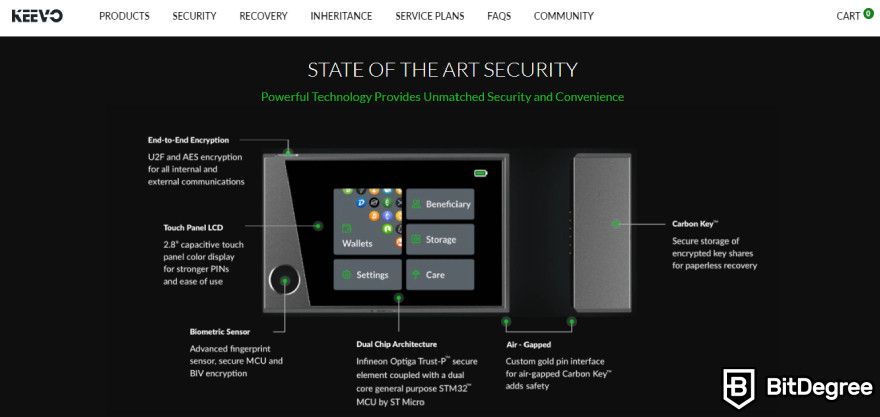
As noted in various Keevo Wallet reviews, this innovative approach places a premium on user protection, with Keevo’s Multi-Factor / Multi-Sig Authentication system (MF/MSA) standing out in the industry. Thanks to this system, users can store, access, and transfer their cryptocurrencies with unprecedented levels of security.
While many wallets only utilize a device and a PIN, Keevo's MF/MSA employs additional layers of security through the integration of biometric data and a separate backup device, the Keevo Carbon Key. The latter not only stores your encrypted sub-keys but also acts as a secure safety net if your primary device is lost, stolen, or damaged.
On top of that, Keevo Wallet incorporates four authentication factors, significantly raising the bar for protection:
- Your Keevo Wallet (something you own);
- Your Strong Password (something you know);
- Your Fingerprint (something unique to you);
- Your Keevo Carbon Key (something you store);
This system is particularly advantageous for users concerned about unauthorized access to their assets. By requiring multiple factors for authentication, Keevo ensures that even if one element is compromised, your assets remain secure.
Many Keevo Wallet reviews consistently highlight the device's focus on security. For instance, if someone were to gain access to your password, they would still need your physical Keevo device and fingerprint to access your crypto holdings.
Additionally, Keevo's MF/MSA leverages Shamir’s Secret Sharing Algorithm, allowing for the potential expansion of security features in the future. Users can anticipate the addition of further authentication factors, such as facial recognition or unique content stored in Keevo[1], which will enhance usability without sacrificing safety.
While Keevo's security measures might sound daunting, the wallet has designed its system to be user-friendly. Daily transactions can be conducted simply by using three of the four factors: your Keevo wallet, fingerprint, and PIN. It's no surprise that many Keevo Wallet reviews frequently mention the 4FA system as a top reason for choosing this wallet for secure crypto storage.
Legacy Protection Through Beneficiary Service
When managing cryptocurrency, many users may overlook the importance of having a beneficiary plan for their digital assets. What happens to your crypto wealth if something unforeseeable occurs? This concern is increasingly relevant as the crypto market grows, and traditional financial systems lack the safeguards to ensure a smooth inheritance process.
Keevo addresses this issue with its Beneficiary Service, allowing users to designate someone to inherit their crypto assets upon passing. During setup, the beneficiary can register their fingerprint and password on the Carbon Key. In the event of the user’s death, the beneficiary can initiate the transfer process by presenting proof of death, such as an original government-issued death certificate.
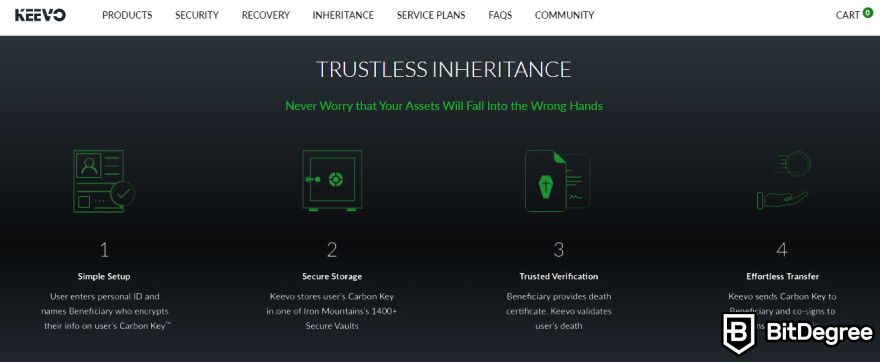
Now, you may recall one key aspect I continuously point out in this Keevo Wallet review: the company's commitment to security through a multi-factor authentication system. Any transfers require co-signing by both the beneficiary and Keevo, adding an extra layer of protection. Before any transfer occurs, Keevo validates the death certificate to ensure the rightful heir is recognized.
Afterward, Keevo provides a comprehensive Beneficiary Service along with secure storage in the Iron Mountain vault to ensure the Carbon Key's security. This service ensures your Carbon Key is protected 24/7 in a monitored facility.
If the beneficiary ever needs access, Keevo will securely ship the Carbon Key to them, ensuring that your digital assets remain protected and accessible to your loved ones. That's why numerous Keevo Wallet reviews have praised this innovative feature, showing how it provides superior digital asset protection.
Paperless Wallet Recovery Solution
One of the most frustrating aspects of using a crypto hardware wallet is managing seed phrases. If you’ve used one before, you’ve probably experienced the anxiety of writing down that random string of words on paper and hiding it away.
While it’s meant to act as a recovery method, it also introduces a huge security risk[2]. Anyone who gets their hands on your seed phrase can access your entire crypto portfolio. Storing that piece of paper securely is a challenge, so it’s no wonder many users feel uneasy about it.
Keevo Wallet addresses this concern head-on with its innovative seedless recovery solution. Instead of relying on a paper seed phrase, Keevo allows users to store their encrypted password, fingerprint, and an additional unique key share on their Carbon Key.
If your Keevo hardware wallet is ever lost, stolen, or damaged, all you need is your Carbon Key to recover your wallet. This feature offers a significant advantage for crypto users, providing peace of mind without the burden of safeguarding a fragile piece of paper. The ability to securely restore your wallet without a seed phrase makes this capability a standout benefit in a lot of Keevo Wallet reviews.

Did you know?
All Crypto wallets may look similar to you but they're NOT all the same!
Keevo Wallet Review: CONS
After going over the Keevo Wallet's standout features, it’s important to acknowledge that no product is without its limitations. A Keevo Wallet review wouldn’t be complete without diving into some of the cons that potential users should consider.
Here’s where Keevo might not meet everyone's expectations.
Relatively Expensive Wallet
When it comes to buying a crypto wallet, price is a significant consideration. So, how much does the Keevo hardware wallet cost? Its Regular Edition is priced at $299, while the Founders Edition comes in at $399.
The only notable differences between the two are the leather box desktop display stand, a premium USB Type-C connector, and an exclusive limited edition serialized numbering in the Founders Edition.
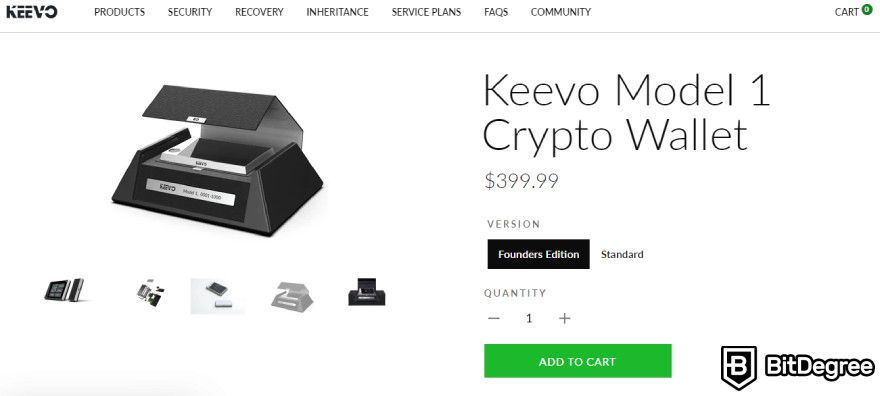
While both editions offer identical core functionality and security, the additional features of the Founders Edition may appeal to early adopters and collectors. However, for the average cryptocurrency investor, the standard edition seems to be a more pragmatic choice since it provides the same robust security at a lower price point.
To give you an idea of where Keevo stands in comparison to its competitors, let’s look at the pricing for similar wallets:
- Ledger Nano S Plus: $79;
- Ledger Nano X: $149;
- Trezor Safe 3: $99;
- Trezor Safe 5: $169.
As you can see, Keevo Wallet's price point is significantly higher than that of its competitors, making it a relatively expensive option in the market.
In addition to the upfront cost of the device, Keevo users must also consider ongoing fees for services such as the Secure Storage service and the Beneficiary Service, which range from $3.99 to $9.99 per month. These additional expenses can add up, especially for users who wish to take full advantage of Keevo's offerings.
So, it's essential to consider whether the premium pricing aligns with your budget and crypto management needs. If you’re looking for more budget-friendly options that still offer reliability, top hardware wallets like the Ledger Nano S Plus or Trezor Safe 3 might be worth considering.
Keevo Wallet Alternatives
Now that we’ve covered the pros and cons in this Keevo Wallet review, it's worth exploring how it measures up against other leading alternatives. Comparing Keevo with some of the top options out there will help paint a clearer picture of which wallet best fits your needs based on what matters most to you.
Keevo Wallet VS Ledger Nano X
One notable advantage of the Keevo Wallet, specifically the Model 1, is its 2.8” capacitive touchscreen that offers a smooth and intuitive user experience. The phone-like display allows users to easily navigate menus and access settings with a simple touch.
In contrast, the Ledger Nano X relies on two physical buttons (on the left and right side) for navigation, which can make entering seed phrases and managing settings more cumbersome. The lack of a touchscreen on the Ledger Nano X can be seen as a drawback for those who prefer a more straightforward interface.
However, Ledger Nano X is more compact, with dimensions of 72mm x 18.6mm x 11.75mm and a weight of 34g. Thus, it is easier to carry in pockets or small bags.
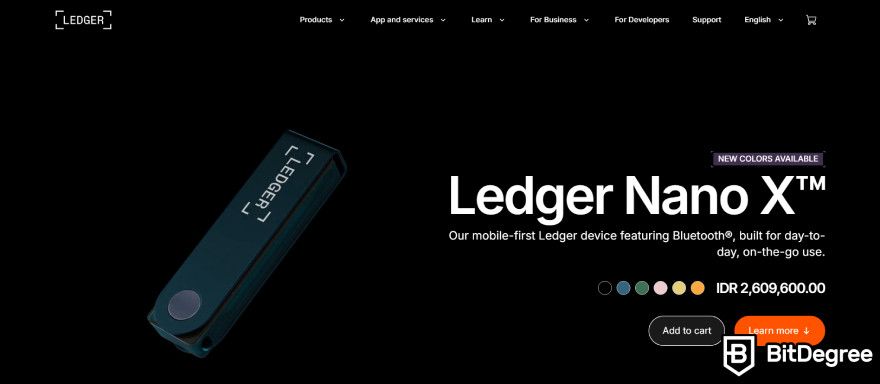
The Keevo Wallet, on the other hand, offers a larger display but is bulkier, which might be less convenient for users who prioritize portability. As a potential buyer, you might want to consider the trade-off between larger- or smaller-form devices.
Additionally, various Keevo Wallet reviews often note how the wallet’s biometric and Carbon Key integration elevates it above standard two-factor authentication (2FA) wallets. Such additional layers of security can be a significant pro for users concerned about unauthorized access.
As for Ledger Nano X, it relies on double-standard security: you'll be asked to create a 4-digit PIN once the wallet arrives safely in your hands. In case you forget the PIN, Ledger thankfully has a failsafe measure in the form of a 24-word recovery phrase. This secret recovery phrase also acts like a firewall against hackers' attacks, requiring your signature to unlock.
Another factor to consider is the range of cryptocurrencies supported by each device. Keevo Wallet offers compatibility with over 1,000 coins. For those interested in less mainstream options, though, the Ledger Nano X shines with support for over 5,500 coins.

Battery life is also worth noting. Keevo boasts a lithium-ion polymer battery that can last up to six hours of continuous use, so it is suitable for extended sessions without frequent recharging. Meanwhile, Ledger Nano X has a smaller 100mAh battery. But don't take the smaller battery size for granted, as Nano X can still last up to 8 hours.
Finally, there's the matter of pricing. The Keevo Wallet is priced at $299 for the Regular Edition and $399 for the Founders Edition. In comparison, the Ledger Nano X is available for $149. Although Keevo offers advanced features like a touchscreen and biometric security, its higher price point may not appeal to users who are looking for a more budget-friendly option.
Keevo Wallet VS Trezor Safe 5
Keevo Wallet and Trezor Safe 5 both offer unique advantages in terms of security and user experience, but they cater to slightly different needs.
A quick glance through general Keevo Wallet reviews reveals how popular the MF/MSA system has become among security-conscious users. With its dual-chip architecture, private keys are never stored—making each transaction more secure by using any 3 out of 4 factors for authentication.
The inclusion of an EAL 5+ certified Secure MCU and the Carbon Key also adds another layer of security, especially in the wallet recovery process, which doesn’t require storing a seed phrase.
Trezor Safe 5, on the other hand, takes a more open-source approach. Built on a decade of open-source development, it provides a solid foundation for users who prioritize transparency and trust.
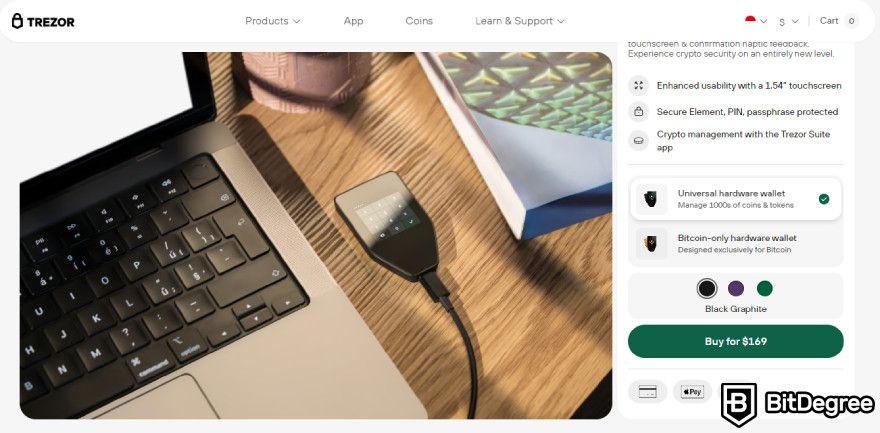
Its NDA-free, EAL 6+ certified Secure Element offers a higher level of protection against brute-force attacks, surpassing Keevo’s EAL 5+ certification. For users who prefer community-vetted security measures, this distinction may tip the scales toward Trezor.
When it comes to usability, both wallets offer unique features, but the Trezor Safe 5 has a clear edge in user-friendliness. Trezor’s color touchscreen with tactile feedback makes navigation smooth and intuitive, much like Keevo’s capacitive touchscreen.
However, the Trezor Safe 5 takes it further with an upgraded design that feels more like using a phone, making it more comfortable to use compared to the previous Trezor models. Keevo’s touchscreen, while functional, is part of a larger and bulkier device.
Another critical difference between the two wallets is how they handle power. Trezor Safe 5 requires an external power source, such as a laptop, to operate, which could be inconvenient for users looking for quick on-the-go access.
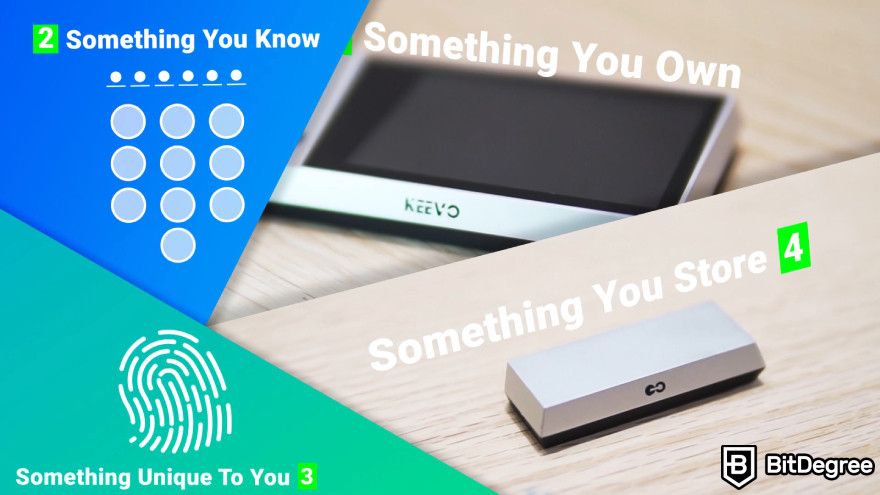
On the other side, Keevo - with its built-in lithium-ion battery - offers more flexibility in this regard, allowing users to manage their assets without being tethered to a computer. While both wallets require an external device for transaction signing, Keevo’s design is more mobile-friendly, though it does come with some trade-offs in terms of size and weight.
The final point to consider is pricing. Keevo’s pricing starts at $299, while the Trezor Safe 5 comes in slightly cheaper at around $130 less than Keevo’s Regular Edition. Ultimately, the choice between the two will depend on individual priorities, whether that’s pricing, security, portability, or overall user experience.
Keevo Wallet Pricing
As we're approaching the end of this Keevo Wallet review, pricing is an essential topic that warrants discussion. The standard edition of the Keevo Wallet costs $299, while the Founders Edition retails for $399. For many, this investment may feel substantial when considering the financial commitment involved in securing your crypto assets.
However, the Keevo Wallet offers notable value for its price. The package includes not only the Keevo Model 1 itself but also the innovative Keevo Carbon Key and a USB Type-C cable.
Additionally, Keevo offers extended service plans that provide even more value and peace of mind. Here’s a quick overview:
| Service Plan | Monthly Cost | Benefits |
|---|---|---|
| Keevo Care | $3.99 |
|
| Secure Storage Service | $6.99 |
|
| Secure Storage and Beneficiary Services | $9.99 |
|
Table: Keevo wallet pricing structure.
While the Keevo Wallet may not fit everyone's budget, its focus on security and convenience can justify the investment for many users. Compared to other hardware wallets in the market, Keevo's pricing remains competitive, especially considering the unique features and safety assurance it provides.
How to Use Keevo Wallet
Understanding the Keevo Wallet is one thing, but setting it up properly is key. Below is a detailed, step-by-step guide to help you get started with your Keevo Wallet:
Step 1: First, head over to Keevo’s official website and download the Keevo desktop software. Once installed, press and hold the button on your Keevo Model 1 to power it on. Connect the device to your computer using the included USB Type-C cable.
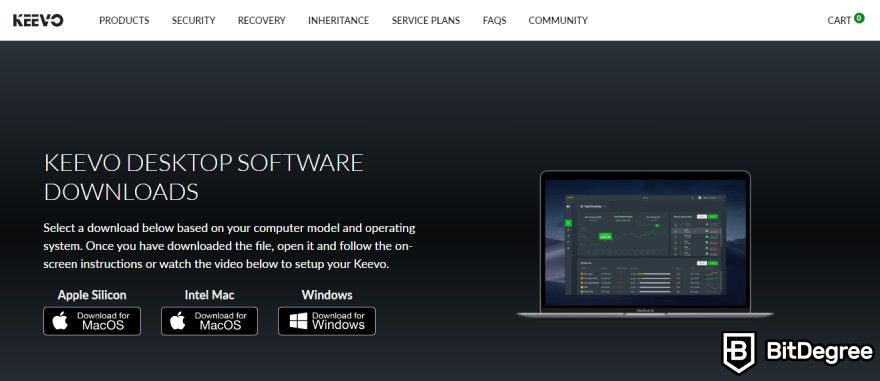
Step 2: When you open the Keevo desktop software, you’ll be prompted to sign in with your email and password. If you don’t already have an account, click on [Create an account] and follow the prompts.
Step 3: After signing in, navigate to the profile icon located in the top right corner of the main page. From there, click on the [Setup] button to begin configuring your wallet.

Step 4: You’ll be presented with three choices:
- Setup a new Keevo Wallet;
- Restore from Carbon Key;
- Restore from seed phrase.
Since this is your first time setting up the Keevo Wallet, select the first option, [Setup a new Keevo Wallet].
Step 5: Enter your Keevo wallet’s serial number, which can be found on the back of the device. After entering the serial number, click the [Check Integrity] button. Once the integrity check is complete, give your wallet a unique name in the next step.
Step 6: Keevo generates your private keys using a hardware-based true random number generator. For even greater security, you’ll have the option to add some random characters (known as “user entropy”).
Simply input any combination of 8 numbers, letters, or symbols. You won’t need to remember what you input here—it’s all about boosting key complexity. Just be sure to mix things up and avoid repeating the same characters.

Step 7: Next, you’ll be asked to create a strong password for your Keevo hardware wallet. Ensure it’s a combination of at least 8 numbers, characters, or symbols to provide optimal security.
Step 8: For an extra layer of security, register your fingerprint by placing your finger on Keevo’s built-in biometric sensor. Follow the prompts to complete the fingerprint registration process.
Step 9: If you’re interested in Keevo’s extended services, this is the point where you’ll choose from the available plans. If you’d prefer not to opt into these services right now, you can skip this step.
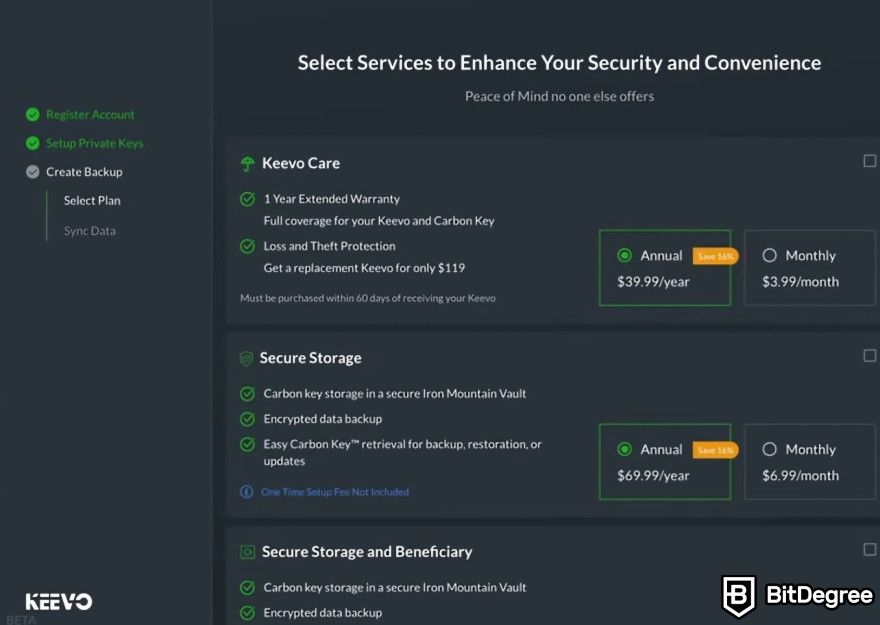
Step 10: Now, connect the Carbon Key to your Keevo Wallet and leave it connected while Keevo encrypts your data. This step may take a little while, so be patient. Be extra careful because removing the Carbon Key prematurely could interrupt the process.
Step 11: Once the setup is complete, you’re ready to manage your assets. You can now start adding coins to your portfolio through the Keevo desktop interface.
Step 12: Use the search bar to find the coins you want to add to your wallet. When you find the correct coin, toggle the option next to it to add it.

If this is your first time adding a coin to Keevo, you’ll be prompted to enter your password. This is a one-time requirement for your first coin transfer.
Step 13: To receive coins, copy the wallet address associated with the coin you’ve just added. You can now transfer your assets and begin securing them with Keevo.
Now that your wallet is set up, you're ready to manage your digital assets with confidence and ease.

- User-friendly design
- Robust security
- Long battery life

- Dual auditable Secure Element chips
- Quantum-resistant protection
- Water and dust resistant

- Transaction Check feature
- Direct dApps connection
- Great middle-ground price
Conclusion
As we're coming to the end of this Keevo Wallet review, it's clear that this hardware wallet brings a unique blend of features to the table. With its intuitive touchscreen and biometric security, Keevo offers a modern approach to managing your crypto assets.
Ultimately, investing in a solid hardware wallet like Keevo is essential for anyone serious about protecting their digital assets. The ease of use and robust security measures make it a worthy consideration, especially for users looking for a secure way to store their cryptocurrencies.
If Keevo’s price is a concern, exploring alternatives like the Ledger Nano X or Trezor Safe 5 can also lead to a solution that fits your needs. Each wallet has its unique strengths, so assess what features are most important to you before making a choice.
The content published on this website is not aimed to give any kind of financial, investment, trading, or any other form of advice. BitDegree.org does not endorse or suggest you to buy, sell or hold any kind of cryptocurrency. Before making financial investment decisions, do consult your financial advisor.
Scientific References
1. G. Ulutas, M. Ulutas, V. V. Nabiyev: ‘Secret image sharing scheme with adaptive authentication strength’;
2. S. T. Bukhari, M. U. Janjua, J. Qadir: ‘Secure Storage of Crypto Wallet Seed Phrase Using ECC and Splitting Technique’.


